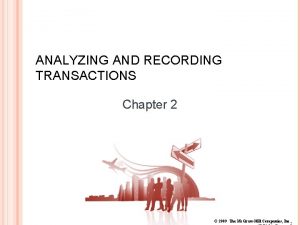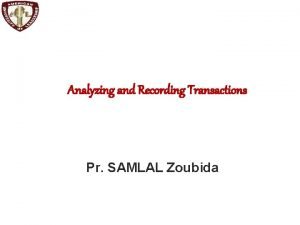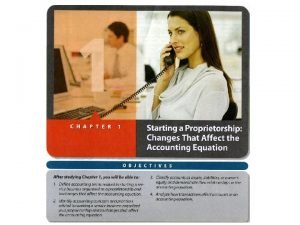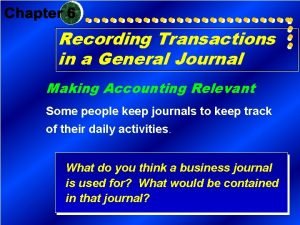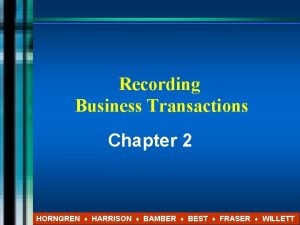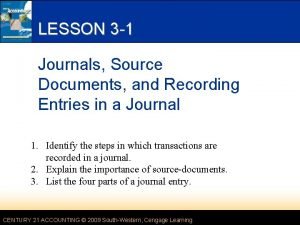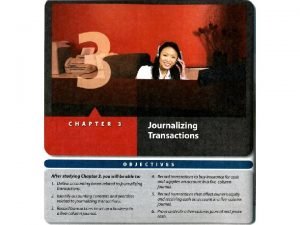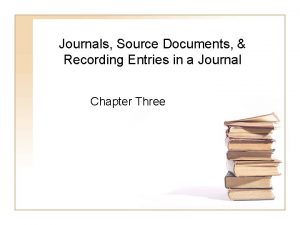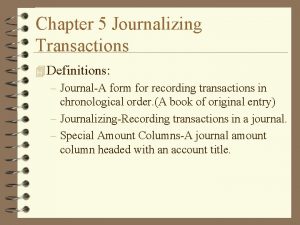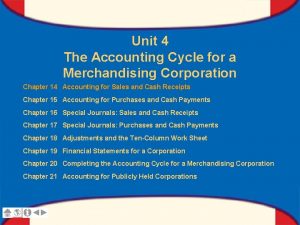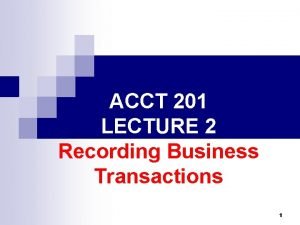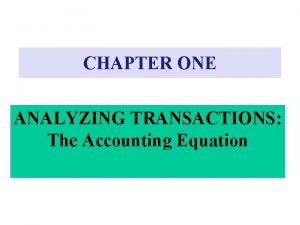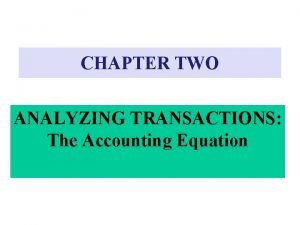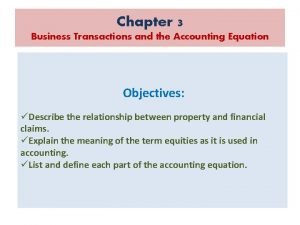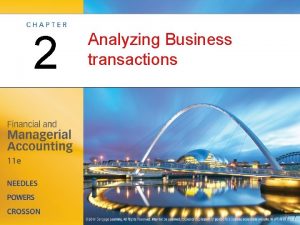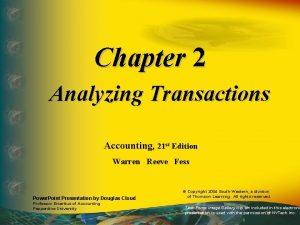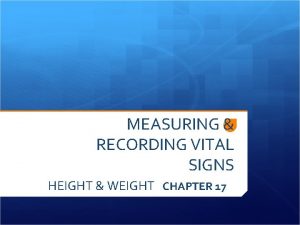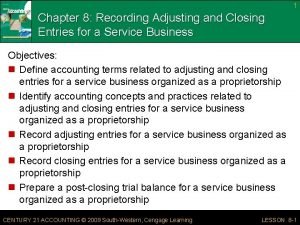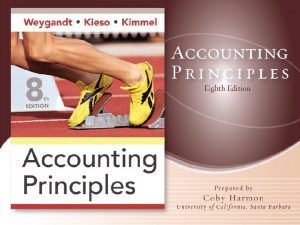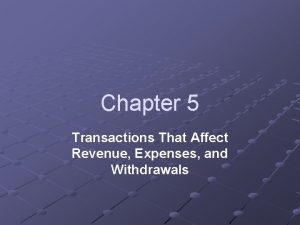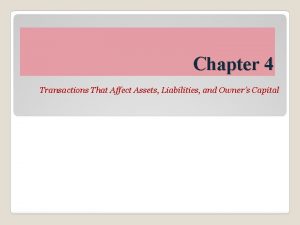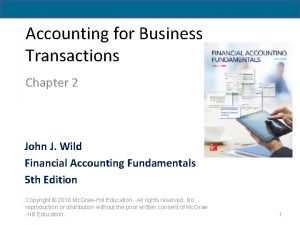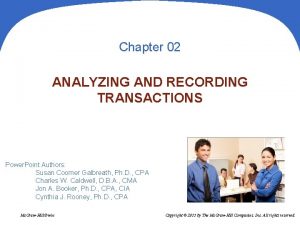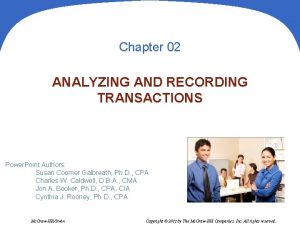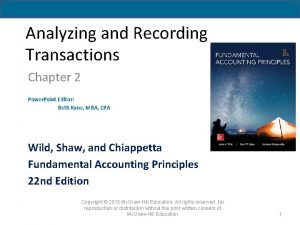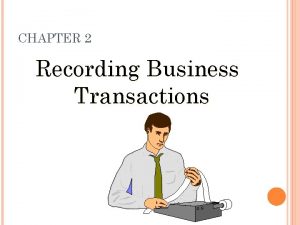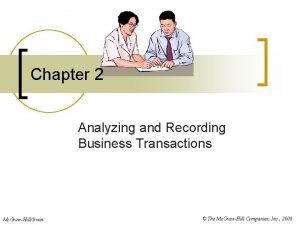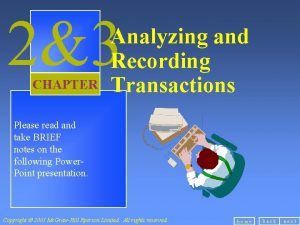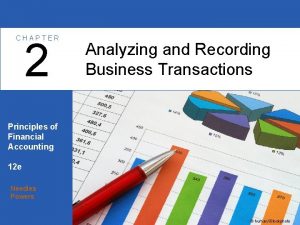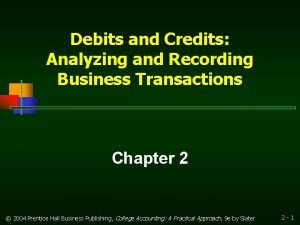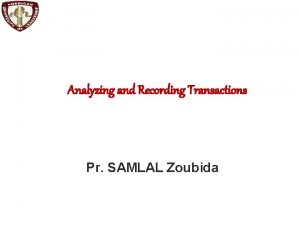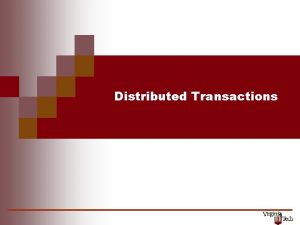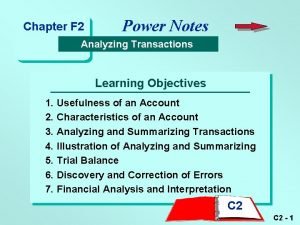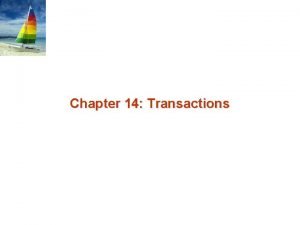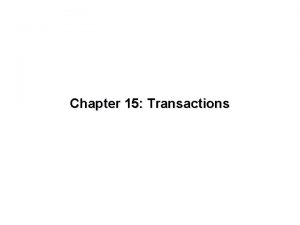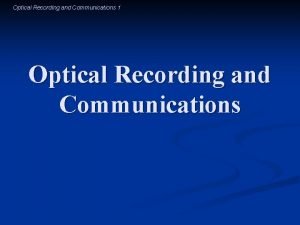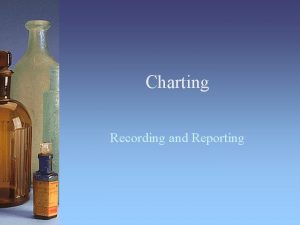Chapter 02 ANALYZING AND RECORDING TRANSACTIONS Power Point








































- Slides: 40

Chapter 02 ANALYZING AND RECORDING TRANSACTIONS Power. Point Authors: Susan Coomer Galbreath, Ph. D. , CPA Charles W. Caldwell, D. B. A. , CMA Jon A. Booker, Ph. D. , CPA, CIA Cynthia J. Rooney, Ph. D. , CPA Mc. Graw-Hill/Irwin Copyright © 2011 by The Mc. Graw-Hill Companies, Inc. All rights reserved.

2 -2 C 1 ANALYZING AND RECORDING PROCESS Analyze each transaction and event from source documents Prepare and analyze the trial balance Record relevant transactions and events in a journal Post journal information to ledger accounts

2 -3 C 1 SOURCE DOCUMENTS Checks Employee Earnings Records Bills from Suppliers Purchase Orders Bank Statements Sales Tickets

2 -4 C 2 THE ACCOUNT AND ITS ANALYSIS An account is a record of increases and decreases in a specific asset, liability, equity, revenue, or expense item. The general ledger is a record containing all accounts used by the company.

2 -5 C 2 THE ACCOUNT AND ITS ANALYSIS Owner, Capital Owner, Withdrawals

2 -6 C 2 ASSET ACCOUNTS Cash Land Buildings Asset Accounts Receivable Notes Receivable Prepaid Accounts Equipment Supplies Prepaid expenses turn into expenses as they are used up

2 -7 C 2 LIABILITY ACCOUNTS Accounts Payable Notes Payable Liability Accounts Accrued Liabilities Unearned Revenue Cash received but product service not delivered

2 -8 C 2 EQUITY ACCOUNTS Owner’s Capital Owner’s Withdrawals Equity Accounts Revenues Owners claim on companys assets Expenses

2 -9 THE ACCOUNT AND ITS ANALYSIS C 2 Assets = Liabilities + Equity

2 - 10 C 3 LEDGER AND CHART OF ACCOUNTS The ledger is a collection of all accounts for an information system. A company’s size and diversity of operations affect the number of accounts needed. The chart of accounts is a list of all accounts and includes an identifying number for each account.

2 - 11 C 4 DEBITS AND CREDITS A T-account represents a ledger account and is a tool used to understand the effects of one or more transactions. When the sum of debits exceeds the credit side you have a debit balance

2 - 12 C 4 DOUBLE-ENTRY ACCOUNTING Assets ASSETS Debit + Normal = Liabilities LIABILITIES Credit - Debit - Credit + Normal + Equity EQUITIES Debit - Credit + Normal For each transaction at least 2 accounts are involved one debit one credit

2 - 13 C 4 DOUBLE-ENTRY ACCOUNTING Equity Owner’s Capital _ Owner's Withdrawals + Revenues Owner’s Capital Owner's Withdrawals Revenues Debit Credit - + + - - + _ Expenses Debit Credit + -

2 - 14 C 4 DOUBLE-ENTRY ACCOUNTING An account balance is the difference between the increases and decreases in an account. Notice the T-Account.

2 - 15 P 1 JOURNALIZING & POSTING TRANSACTIONS Assets Step 1: Analyze transactions and source documents. Step 4: Post entry to ledger = Liabilities + Equity Step 2: Apply doubleentry accounting Step 3: Record journal entry

2 - 16 P 1 JOURNALIZING TRANSACTIONS ŒTransaction Date Transaction explanation Titles of Affected Accounts Dollar amount of debits and credits

2 - 17 P 1 BALANCE COLUMN ACCOUNT T-accounts are useful illustrations, but balance column ledger accounts are used in practice.

2 - 18 P 1 POSTING JOURNAL ENTRIES 1 Identify the debit account in ledger.

2 - 19 P 1 POSTING JOURNAL ENTRIES 2 Enter the date.

2 - 20 P 1 POSTING JOURNAL ENTRIES 3 Enter the amount and description.

2 - 21 P 1 POSTING JOURNAL ENTRIES 4 Enter the journal reference.

2 - 22 P 1 POSTING JOURNAL ENTRIES 5 Compute the balance.

2 - 23 P 1 POSTING JOURNAL ENTRIES 6 Enter the ledger reference.

2 - 24 A 1 ANALYZING TRANSACTIONS Analysis: Double entry: Posting: 101 301

2 - 25 A 1 ANALYZING TRANSACTIONS Analysis: Double entry: Posting: 126 101

2 - 26 A 1 ANALYZING TRANSACTIONS Analysis: Double entry: Posting: 167 101

2 - 27 A 1 ANALYZING TRANSACTIONS Analysis: Double entry: Posting: 126 201

2 - 28 A 1 ANALYZING TRANSACTIONS Analysis: Double entry: Posting: 403 101

2 - 29 P 2 After processing its remaining transactions for December, Fast. Forward’s Trial Balance is prepared. Fast. Forward Trial Balance December 31, 2011 Cash Accounts receivable Supplies Prepaid Insurance Equipment Accounts payable Unearned consulting revenue C. Taylor, Capital Owner's Withdrawals Consulting revenue Rental revenue Salaries expense Rent expense Utilities expense Total Debits $ 4, 350 9, 720 2, 400 26, 000 Credits $ 6, 200 3, 000 30, 000 200 5, 800 300 1, 400 1, 000 230 $ 45, 300 The trial balance lists all account balances in the general ledger. If the books are in balance, the total debits will equal the total credits.

P 2 PREPARING A TRIAL BALANCE Preparing a trail balance involves three steps: 1. List each account title and its amount (from ledger) in the trial balance. If an account has a zero balance, list it with a zero in the normal balance column (or omit it entirely). 2. Compute the total of debit balances and the total of credit balances. 3. Verify (prove) total debit balances equal total credit balances. 2 - 30

2 - 31 P 2 SEARCHING FOR AND CORRECTING ERRORS If the trial balance does not balance, the error(s) must be found and corrected. Make sure the trial balance columns are correctly added. Re-compute each account balance in the ledger. Make sure account balances are correctly entered from the ledger. Verify that each journal entry is posted correctly. See if debit or credit accounts are mistakenly placed on the trial balance. Verify that each original journal entry has equal debits and credits.

2 - 32 P 3 USING A TRIAL BALANCE TO PREPARE FINANCIAL STATEMENTS

2 - 33 P 3 INCOME STATEMENT

2 - 34 P 3 STATEMENT OF OWNER'S EQUITY FASTFORWARD Statement of Owner's Equity For the Month Ended December 31, 2011 Connections C. Taylor, Capital 12/1/11 Net income for December Plus: Investments by Owner Less: Owner Withdrawals C. Taylor, Capital, 12/31/11 $ $ 3, 470 30, 000 33, 470 200 33, 270

2 - 35 P 3 BALANCE SHEET FASTFORWARD Statement of Owner's Equity For the Month Ended December 31, 2011 C. Taylor, Capital 12/1/11 Net income for December Plus: Investments by Owner Less: Owner Withdrawals C. Taylor, Capital, 12/31/11 $ $ 3, 470 30, 000 33, 470 200 33, 270 Connections

2 - 36 P 3 PRESENTATION ISSUES 1. Dollar signs are not used in journals and ledgers. 2. Dollar signs appear in financial statements and other reports such as trial balances. The usual practice is to put dollar signs beside only the first and last numbers in a column. 3. When amounts are entered in the journal, ledger, or trial balance, commas are optional to indicate thousands, millions, and so forth. 4. Commas are always used in financial statements. 5. Companies commonly round amounts in reports to the nearest dollar, or even to a higher level.

2 - 37 GLOBAL VIEW Both U. S. GAAP and IFRS prepare the same four basic financial statements. A few differences are found within each statement, but over time these differences are likely to be eliminated. Here is a typical IFRS balance sheet presentation:

2 - 38 ACCOUNTING CONTROLS AND ASSURANCE Accounting systems depend on control procedures that assure the proper principles were applied in processing accounting information. The passage of SOX legislation strengthened U. S. control procedures in recent years. The percentage of employees in information technology that report observing specific types of misconduct in 2009.

2 - 39 A 2 DEBT RATIO Total Liabilities Debt Ratio = Total Assets Evaluates the level of debt risk. A higher ratio indicates that there is a greater probability that a company will not be able to pay it’s debt in the future.

2 - 40 END OF CHAPTER 02
 Analyzing and recording transactions
Analyzing and recording transactions Analyzing and recording transactions
Analyzing and recording transactions Part two analyzing transactions in a cash control system
Part two analyzing transactions in a cash control system Part 2 analyzing the effect of transactions
Part 2 analyzing the effect of transactions List six reasons why a bank may dishonor a check
List six reasons why a bank may dishonor a check Planning recording analyzing and interpreting
Planning recording analyzing and interpreting Problem 6-1 analyzing a source document
Problem 6-1 analyzing a source document Problem 6-2 recording business transactions
Problem 6-2 recording business transactions A form describing the goods or services sold
A form describing the goods or services sold A form describing the goods or services sold
A form describing the goods or services sold Two column general journal
Two column general journal Source document
Source document A form for recording transactions in chronological order
A form for recording transactions in chronological order Chapter 3 journalizing transactions
Chapter 3 journalizing transactions Chapter 3 journalizing transactions
Chapter 3 journalizing transactions Glencoe accounting chapter 14
Glencoe accounting chapter 14 Which sequence correctly summarizes the accounting process?
Which sequence correctly summarizes the accounting process? Analyzing transactions example
Analyzing transactions example Analyzing transactions
Analyzing transactions Analyzing transactions example
Analyzing transactions example Problem 3-11 describing business transactions
Problem 3-11 describing business transactions Accounting device used to analyze transactions
Accounting device used to analyze transactions Analyzing business transactions
Analyzing business transactions Analyzing transactions in a cash control system
Analyzing transactions in a cash control system Analyzing and visualizing data with microsoft power bi
Analyzing and visualizing data with microsoft power bi Draw power triangle
Draw power triangle Power bi training powerpoint
Power bi training powerpoint Point point power
Point point power Chapter 14:3 measuring and recording pulse
Chapter 14:3 measuring and recording pulse Chapter 16 2 measuring and recording temperature
Chapter 16 2 measuring and recording temperature Chapter 16:7 measuring and recording blood pressure
Chapter 16:7 measuring and recording blood pressure Chapter 15:1 measuring and recording vital signs
Chapter 15:1 measuring and recording vital signs Chapter 21:1 measuring/recording height and weight
Chapter 21:1 measuring/recording height and weight Tpr graphic sheet
Tpr graphic sheet Century 21 accounting chapter 8 study guide answers
Century 21 accounting chapter 8 study guide answers The recording process in accounting
The recording process in accounting Posting normally occurs before journalizing
Posting normally occurs before journalizing Point-to-point airline advantages and disadvantages
Point-to-point airline advantages and disadvantages Chapter 5 transactions that affect
Chapter 5 transactions that affect Problem 4-1 applying the rules of debit and credit
Problem 4-1 applying the rules of debit and credit Accounting business transactions
Accounting business transactions
